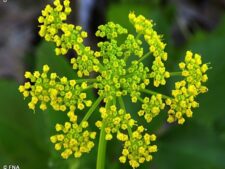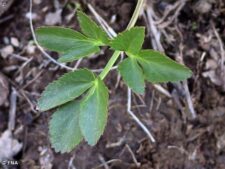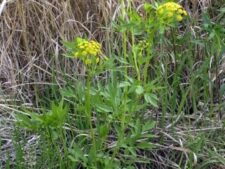
GOLDEN ALEXANDERS
Zizia aurea
PARSLEY FAMILY (Apiaceae)
 Identification
Identification
- Flowering time - May, June
- Common in prairies at NW
- Umbrella-shaped yellow flower clusters
- Leaves divided into 3 leaflets
- Wild Parsnip (Pastinaca sativa) flowers later and has leaves with 5-15 leaflets
This native, short-lived, 1-3 foot tall perennial has erect, branching stems often tinged with red. The alternate, compound upper leaves are divided into 3 finely toothed leaflets (A). The lower leaves may actually have 3 sets of 3 or more leaflets (C). The 10-20 groups (umbels) of tiny 1/8th inch flowers (B) combine to form shallow, umbrella-shaped flower clusters (compound umbels)(D). By August the leaves turn wine red (E).
Golden Alexanders occurs in prairies and open sites flowering in May and June. It is common in the restored prairies at Neale Woods.
The compound leaves with 3 leaflets separate this plant from Wild Parsnip (Pastinaca sativa), an escaped garden veggie “gone bad,” and a nuisance in some areas. It has pinnately compound leaves of 5-15 leaflets. Wild Parsnip also flowers later in the season.
Early settlers thought this plant would cure syphilis and promote wound healing.
Other common names include Wild Parsley and Golden Parsnip.
The content of NatureSearch is provided by dedicated volunteer Naturalists of Fontenelle Forest who strive to provide the most accurate information available. Contributors of the images retain their copyrights. The point of contact for this page is: Neal Ratzlaff.




